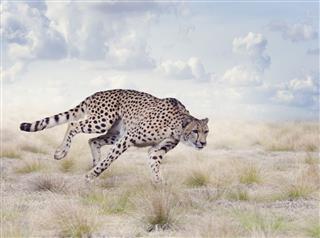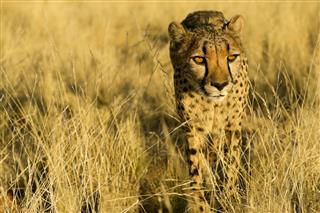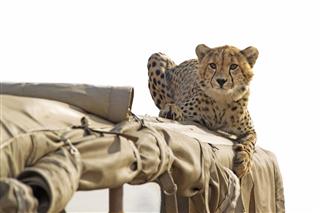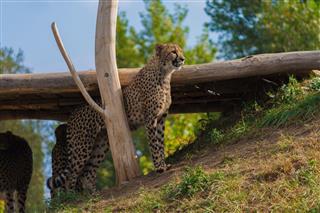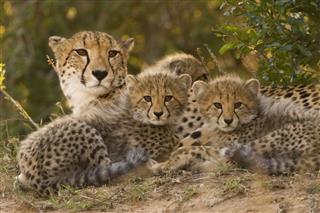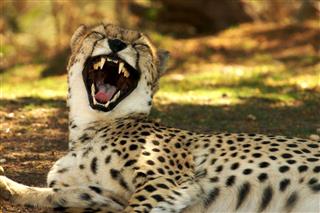
Agile, swift, graceful, lethal…words fail to describe the magnificence of this particular predator from the cat family. A closer run-down of the statuesque cheetah.
The name cheetah traces its derivation from the expression Chitraka, which in the ancient Indian language of Sanskrit means ‘speckled’. This animal exudes a fierce and regal demeanor. The cheetah’s hound-like features doubled up with phantom-like stalking abilities and instincts make it one of the most intelligent and formidable predators around.
Watching them bask in the wild as they unleash their animal instincts is a breathtaking experience and a truly admirable sight.
Cheetah Anecdotes
The Lamborghini ‘Murcielago Lp640’ braced with a V-12 engine, 6496cc capacity cylinder, 4 valves on each cylinder, impressive Pirelli P-Zero ‘ROSSO’ racing tires, equipped with six gears and all the works, propels to breakneck electric speeds with an acceleration of 62 mph in 3.8 seconds. Four slender legs of the cheetah, graced with a flexible spine, do the talking and eclipse this very car’s performance, with an acceleration rate of 0 to over 100 in just 3 seconds – just another day in the life of a cheetah.
The cheetah righteously stands unparalleled as the fastest animal on this planet. On a hunt, it blurs its presence in a flash with a series of short bursts, covering stretches up to 500 meters (1600 feet) at astonishing speeds ranging around 75 mph. True Story!
Duma is the translation of cheetah in Swahili, and is also the name of a popular feature movie about the story of an orphaned boy who befriends a cheetah.
Cheetahs are often confused with another spectacular animal – the leopard. The cheetah is characterized by two warrior-like slick, black tear lines, which prominently descend along the eyes to the base of its mouth, and the body outline is much more lithe in comparison to the leopard’s petite and bulky exterior.
The cheetah’s reedy exterior is characterized by a strapping narrow waist with long and sturdy legs, and a deep chest. This creature has blunt claws which are semi-retractable. It weighs from around 75 to 145 pounds, and is about three feet tall at the shoulders. The head is smaller and cat-like in comparison to its body. The total body length of a cheetah ranges between 110 – 135 cm., with its tail length sometimes reaching to about eighty four centimeters.
Female cheetahs produce a distinct growl when in heat, and the male cheetah then responds to the courtship. The female cheetah nurses pregnancy for about 3 months, and finally gives birth to the cubs in a safe and secluded surrounding, as helpless cheetah cubs are randomly hunted by hyenas and lions. The cubs go unattended for most of the time, as the female wanders around in search of food.
Cheetah cubs grow up rather quickly and make futile attempts to chase and catch prey, or even wrestle amongst each other. When about six weeks old, the cubs follow their mother and eat from her kills, as she watches on. They gain maturity at 18 months of age.
Male cheetahs in a group are as thick as thieves and form a strong brotherhood amongst each other. They also ferociously secure their territories against other male cheetahs.
Amongst the other resplendent features of the cheetah, the coat is a fascinating blend of small and coarse black spots spread over its glistening fur, with a gray patch of fluff outlining underneath the neck and along the belly till the hind. This lower portion of the cheetah’s body is not spotted. The coat works as an ideal tailor-made camouflage, as this animal stealthily lurks in the long yellow grasslands closing in on the kill. The cheetah’s silhouette torso complements its speed, making it the fastest animal that walks the earth.
It has many unique anatomical adaptations which contribute to its speed. It has large nostrils with an enlarged heart, and its lungs enable it to optimize its oxygen intake. The heart and lungs work together to facilitate respiration better and efficiently as compared to other animals. The tail with a bushy white tuft on the tip, coordinates steering the body movements like a rudder on hard chases with sharp turns and twists.
Cheetahs are known to go for two or three days without drinking water.
The cheetah cannot roar like its other big cat counterparts. The growl of a cheetah, when angered, is uncanny yet distinct, characterized by spitting and hissing. Purring and stuttering are signs of contentment, often emanated during mating or socializing.
The cheetah is a lone ranger of sorts, and often hunts alone or sometimes in groups, depending on the size of a prey. The hunts are preferably commenced either early at dawn or late in the evenings, which makes these carnivores diurnal predators.
A cheetah, despite its speed, tires quickly on long chases, and will give up the hunt if takes too long to maul the prey.
Vision, in comparison to scent, is an integral factor in the cheetah’s hunt. The cheetah stalks its prey for an average of about 20 – 30 meters, and then begins the drumroll with the cheetah tearing a chase down on its prey, which usually takes a little less than a minute.
Hunting techniques include tripping the prey on a chase, and then suffocating it by sinking its teeth on the underside of the throat, tactfully cutting off the air supply by puncturing the vital artery inside the neck of the prey. The cheetah then proceeds to secure its prey from falling into the clutches of other predators like hyenas and lions.
The cheetah is vulnerable and the least adaptable in the entire cat kingdom. Its lifespan is twelve years in the wild and twenty years in captivity. Hunts are usually all about small and medium-sized preys in accordance with the surroundings. The cheetah eats mammals weighing even up to hundred pounds. Some of its oft-hunted prey include the Thomson’s Gazelle, impala, wildebeests and calves. It also hunts guinea-fowls and hares.
Akbar the Great, was believed to domesticate a total of 9,000 cheetahs, and would maintain detailed records of each of these animals. The cheetah was dubbed as the ‘Khasa’ or Imperial Cheetah during this time.
Instances and records of China and Europe in the mid twentieth century prove the existence of a royal sport called ‘coursing’, that involved cheetahs with a hood draped around the head, who were taken on carts drawn by cows and horses into the forests with a rider. The purpose of the hood was to prevent the cheetah from seeing the prey that was supposed to be caught. The rider would then remove the hood and the cheetah would dash out in a frenzy like a bat out of hell, chasing the prey, and would be rewarded with a huge chunk of meat on pinning it, after which it would be escorted back to the stables.
Cheetahs were ferried across from Africa to India and Iran in large numbers, where they were bred and tamed for accompanying the kings on their hunts. They were also known as the ‘Hunting Leopards’. Shockingly, their entire numbers have been wiped out completely in India due to poaching and habitat encroachment. The Indian government is now in talks with Iran for retaining the cheetah’s existence in India, by requesting the Iranian government to send a pair of Asiatic cheetahs to India and setting up breeding grounds in the country. The Indian Government is also spearheading wildlife projects for the conservation of the cheetah.
A major survival threat to their existence is inbreeding (mating within the same family members), as it reduces immunity in them, making them prone and susceptible to diseases and ecological changes. Inbreeding is also harmful for most other animals like dogs and horses.
The cheetah, today, can primarily be spotted in eastern and southwestern regions of Africa and some parts of Iran. Only about 7,000 – 10,000 of their numbers on the planet survive today.
The cheetah’s and human companionship dates back to countless decades ago. Initially, cheetah and man, together, were always hunting partners. Cheetahs have been known to chase down their prey, whilst man would round up the catch. The Egyptians and Persians followed by Indians would engage cheetahs in hunting sports. They have also been bred as royal pets and have sufficed a series of folklores and symbolic religious depictions through paintings about them in many cultures. Genghis Khan, Mughal Emperor Akbar, Charlemagne, and in modern times the Emperor of Abyssinia – Haile Selassie, were amongst the noted personalities to domesticate this animal. However, the irony is that, people nowadays prefer looking at the skin of the animal rather than the animal itself, whilst the hunter has now become the hunted.


































